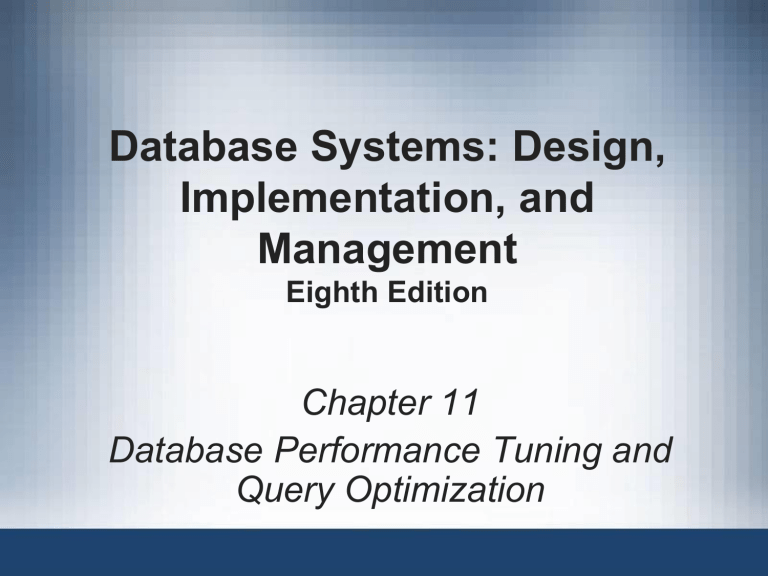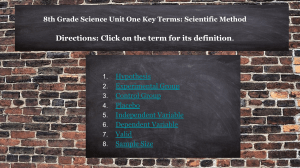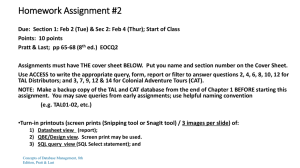
Database Systems: Design, Implementation, and Management Eighth Edition Chapter 11 Database Performance Tuning and Query Optimization Objectives • In this chapter, you will learn: – Basic database performance-tuning concepts – How a DBMS processes SQL queries – About the importance of indexes in query processing Database Systems, 8th Edition 2 Objectives (continued) • In this chapter, you will learn: (continued) – About the types of decisions the query optimizer has to make – Some common practices used to write efficient SQL code – How to formulate queries and tune the DBMS for optimal performance Database Systems, 8th Edition 3 Database Performance-Tuning Concepts • Goal of database performance is to execute queries as fast as possible • Database performance tuning – Set of activities and procedures designed to reduce response time of database system • All factors must operate at optimum level with minimal bottlenecks • Good database performance starts with good database design Database Systems, 8th Edition 4 Database Systems, 8th Edition 5 Performance Tuning: Client and Server • Client side – Generate SQL query that returns correct answer in least amount of time • Using minimum amount of resources at server – SQL performance tuning • Server side – DBMS environment configured to respond to clients’ requests as fast as possible • Optimum use of existing resources – DBMS performance tuning Database Systems, 8th Edition 6 DBMS Architecture • All data in database are stored in data files • Data files – Automatically expand in predefined increments known as extends – Grouped in file groups or table spaces • Table space or file group: – Logical grouping of several data files that store data with similar characteristics Database Systems, 8th Edition 7 Database Systems, 8th Edition 8 DBMS Architecture (continued) • Data cache or buffer cache: shared, reserved memory area – Stores most recently accessed data blocks in RAM • SQL cache or procedure cache: stores most recently executed SQL statements – Also PL/SQL procedures, including triggers and functions • DBMS retrieves data from permanent storage and places it in RAM Database Systems, 8th Edition 9 DBMS Architecture (continued) • Input/output request: low-level data access operation to/from computer devices • Data cache is faster than data in data files – DBMS does not wait for hard disk to retrieve data • Majority of performance-tuning activities focus on minimizing I/O operations • Typical DBMS processes: – Listener, User, Scheduler, Lock manager, Optimizer Database Systems, 8th Edition 10 Database Statistics • Measurements about database objects and available resources – – – – – Tables Indexes Number of processors used Processor speed Temporary space available Database Systems, 8th Edition 11 Database Statistics (continued) • Make critical decisions about improving query processing efficiency • Can be gathered manually by DBA or automatically by DBMS Database Systems, 8th Edition 12 Database Systems, 8th Edition 13 Query Processing • DBMS processes queries in three phases – Parsing • DBMS parses the query and chooses the most efficient access/execution plan – Execution • DBMS executes the query using chosen execution plan – Fetching • DBMS fetches the data and sends the result back to the client Database Systems, 8th Edition 14 Database Systems, 8th Edition 15 SQL Parsing Phase • Break down query into smaller units • Transform original SQL query into slightly different version of original SQL code – Fully equivalent • Optimized query results are always the same as original query – More efficient • Optimized query will almost always execute faster than original query Database Systems, 8th Edition 16 SQL Parsing Phase (continued) • Query optimizer analyzes SQL query and finds most efficient way to access data – Validated for syntax compliance – Validated against data dictionary • Tables, column names are correct • User has proper access rights – Analyzed and decomposed into components – Optimized – Prepared for execution Database Systems, 8th Edition 17 SQL Parsing Phase (continued) • Access plans are DBMS-specific – Translate client’s SQL query into series of complex I/O operations – Required to read the data from the physical data files and generate result set • DBMS checks if access plan already exists for query in SQL cache • DBMS reuses the access plan to save time • If not, optimizer evaluates various plans – Chosen plan placed in SQL cache Database Systems, 8th Edition 18 Database Systems, 8th Edition 19 SQL Execution Phase SQL Fetching Phase • All I/O operations indicated in access plan are executed – Locks acquired – Data retrieved and placed in data cache – Transaction management commands processed • Rows of resulting query result set are returned to client • DBMS may use temporary table space to store temporary data Database Systems, 8th Edition 20 Query Processing Bottlenecks • Delay introduced in the processing of an I/O operation that slows the system – – – – – CPU RAM Hard disk Network Application code Database Systems, 8th Edition 21 Indexes and Query Optimization • Indexes – Crucial in speeding up data access – Facilitate searching, sorting, and using aggregate functions as well as join operations – Ordered set of values that contains index key and pointers • More efficient to use index to access table than to scan all rows in table sequentially Database Systems, 8th Edition 22 Indexes and Query Optimization (continued) • Data sparsity: number of different values a column could possibly have • Indexes implemented using: – Hash indexes – B-tree indexes – Bitmap indexes • DBMSs determine best type of index to use Database Systems, 8th Edition 23 Database Systems, 8th Edition 24 Optimizer Choices • Rule-based optimizer – Preset rules and points – Rules assign a fixed cost to each operation • Cost-based optimizer – Algorithms based on statistics about objects being accessed – Adds up processing cost, I/O costs, resource costs to derive total cost Database Systems, 8th Edition 25 Database Systems, 8th Edition 26 Using Hints to Affect Optimizer Choices • Optimizer might not choose best plan • Makes decisions based on existing statistics – Statistics may be old – Might choose less efficient decisions • Optimizer hints: special instructions for the optimizer embedded in the SQL command text Database Systems, 8th Edition 27 Database Systems, 8th Edition 28 SQL Performance Tuning • Evaluated from client perspective – Most current relational DBMSs perform automatic query optimization at the server end – Most SQL performance optimization techniques are DBMS-specific • Rarely portable • Majority of performance problems related to poorly written SQL code • Carefully written query usually outperforms a poorly written query Database Systems, 8th Edition 29 Index Selectivity • Indexes are used when: – Indexed column appears by itself in search criteria of WHERE or HAVING clause – Indexed column appears by itself in GROUP BY or ORDER BY clause – MAX or MIN function is applied to indexed column – Data sparsity on indexed column is high • Measure of how likely an index will be used Database Systems, 8th Edition 30 Index Selectivity (continued) • General guidelines for indexes: – Create indexes for each attribute in WHERE, HAVING, ORDER BY, or GROUP BY clause – Do not use in small tables or tables with low sparsity – Declare primary and foreign keys so optimizer can use indexes in join operations – Declare indexes in join columns other than PK/FK Database Systems, 8th Edition 31 Conditional Expressions • Normally expressed within WHERE or HAVING clauses of SQL statement • Restricts output of query to only rows matching conditional criteria Database Systems, 8th Edition 32 Conditional Expressions (continued) • Common practices for efficient SQL: – – – – – – – – Use simple columns or literals in conditionals Numeric field comparisons are faster Equality comparisons faster than inequality Transform conditional expressions to use literals Write equality conditions first AND: Use condition most likely to be false first OR: Use condition most likely to be true first Avoid NOT Database Systems, 8th Edition 33 Query Formulation • Identify what columns and computations are required • Identify source tables • Determine how to join tables • Determine what selection criteria is needed • Determine in what order to display output Database Systems, 8th Edition 34 DBMS Performance Tuning • Includes managing DBMS processes in primary memory and structures in physical storage • DBMS performance tuning at server end focuses on setting parameters used for: – – – – Data cache SQL cache Sort cache Optimizer mode Database Systems, 8th Edition 35 DBMS Performance Tuning (continued) • Some general recommendations for creation of databases: – Use RAID (Redundant Array of Independent Disks) to provide balance between performance and fault tolerance – Minimize disk contention – Put high-usage tables in their own table spaces – Assign separate data files in separate storage volumes for indexes, system, high-usage tables Database Systems, 8th Edition 36 DBMS Performance Tuning (continued) • Some general recommendations for creation of databases: (continued) – Take advantage of table storage organizations in database – Partition tables based on usage – Use denormalized tables where appropriate – Store computed and aggregate attributes in tables Database Systems, 8th Edition 37 Query Optimization Example • Example illustrates how query optimizer works • Based on QOVENDOR and QOPRODUCT tables • Uses Oracle SQL*Plus Database Systems, 8th Edition 38 Database Systems, 8th Edition 39 Database Systems, 8th Edition 40 Database Systems, 8th Edition 41 Database Systems, 8th Edition 42 Database Systems, 8th Edition 43 Database Systems, 8th Edition 44 Database Systems, 8th Edition 45 Database Systems, 8th Edition 46 Database Systems, 8th Edition 47 Summary • Database performance tuning – Refers to activities to ensure query is processed in minimum amount of time • SQL performance tuning – Refers to activities on client side to generate SQL code • Returns correct answer in least amount of time • Uses minimum amount of resources at server end • DBMS architecture represented by processes and structures used to manage a database Database Systems, 8th Edition 48 Summary (continued) • Database statistics refers to measurements gathered by the DBMS – Describe snapshot of database objects’ characteristics • DBMS processes queries in three phases: parsing, execution, and fetching • Indexes are crucial in process that speeds up data access Database Systems, 8th Edition 49 Summary (continued) • During query optimization, DBMS chooses: – Indexes to use, how to perform join operations, table to use first, etc. • Hints change optimizer mode for current SQL statement • SQL performance tuning deals with writing queries that make good use of statistics • Query formulation deals with translating business questions into specific SQL code Database Systems, 8th Edition 50



